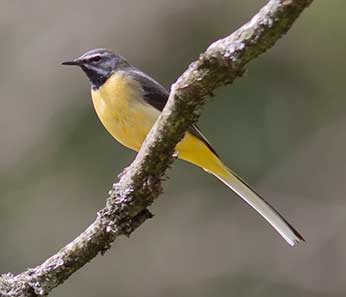Grey wagtail (Motacilla cinerea)
When: Mainly spring and summer
How many:
Reasonably abundant in favoured places

Grey wagtails are graceful inhabitants of fast flowing, gravel-bottomed New Forest streams, a joy to watch, splashes of extravagant golden-yellow amongst the typically more sombre tones.
They are most frequently encountered as breeding birds in spring and summer, although small numbers of grey wagtails in winter can sometimes be seen, most often around sewage farms or other such places with abundant insects present.
The long, wagging tail is rarely still, although it is the yellow breast, yellow under-parts and yellow-green rump that are the grey wagtail's most conspicuous features. But grey upperparts give this bird its first name, and distinguish it from the increasingly scarce, yellow wagtail, a creature now rarely seen on the Crown Lands of the New Forest.
Whilst sometimes taking insect prey in mid-air, and occasionally venturing into the water, grey wagtails can most often be seen feeding on the ground, often a pair together, weaving erratically on mid-stream gravel banks as they pick tiny food items from amongst the stones.
Favourite nest sites in days gone by were amongst the supports of rickety old bridges. But many of these structures have now been replaced with modern versions that offer grey wagtails fewer opportunities to build, and so the birds find holes or crevices amongst tangled, waters-edge tree roots, or use holes or ledges forged out of the stream banks by rushing spate waters.
But use of such sites often means a precarious existence for the grey wagtails, as nests are often threatened by flooding following periods of heavy rain. Disturbance is also a problem - the streams increasingly attract visitors intent on picnicking on the banks, using rope swings, splashing in the water or encouraging dogs to swim, all with potentially disastrous consequences.
Complete surveys of the New Forest streams in 1981, 1982 and 1983 found 57, 65 and 48 pairs of grey wagatils, respectively. Ringing recoveries suggest post-breeding dispersal within southern England and down into mainland Europe.
Wider grey wagtail distribution in Britain primarily follows that of fast flowing streams – very much northerly and westerly – and though for different reasons, is very similar to that of those other New Forest favourites, the redstart and wood warbler.
References:
Collins Bird Guide: Killian Mullarney, Lars Svensson, Dan Zetterstrom and Peter J.Grant
Birds of Hampshire: Hampshire Ornithological Society
Hampshire Bird Reports: Hampshire Ornithological Society
The New Atlas of Breeding Birds in Britain and Ireland (1988-91): D.W. Gibbons, J.B. Reid and R.A. Chapman
The New Forest: Its History and Scenery: John R. Wise.
The Migration Atlas: British Trust for Ornithology
More links
Other related links
Search this site

Sadly, 58 animals were killed - 35 ponies, 13 cows, 8 donkeys and 2 sheep, whilst a further 32 were injured - 3 pigs, 9 donkeys, 11 cows and 9 ponies.
(Forty-three accidents occurred in daylight, 15 at twilight and 101 in the dark. Twenty-seven accidents were not reported by the driver involved).
Here's just one horrific example - Three donkeys killed in collision with van at notorious New Forest blackspot (Advertiser and Times)

